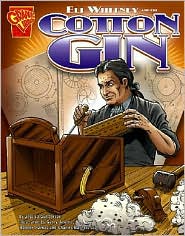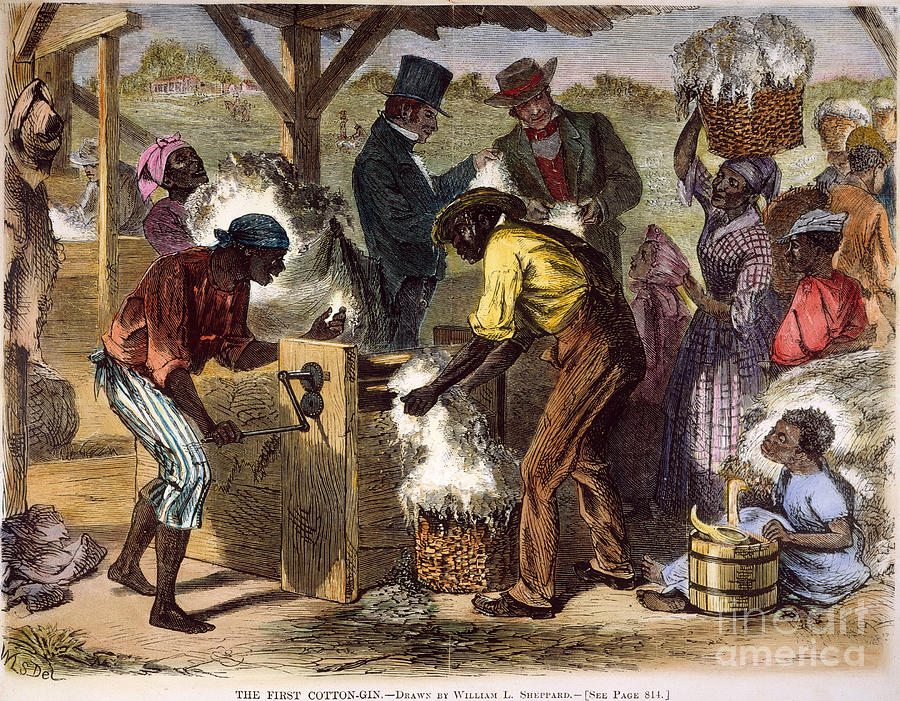
Eli Whitney and the Need for an Invention
As Eli Whitney left New England and headed South in 1792, he had no idea that within the next seven months he would invent a machine that would profoundly alter the course of American history. A recent graduate of Yale, Whitney had given some thought to becoming a lawyer. But, like many college graduates of today, he had debts to repay first and needed a job. Reluctantly, he left his native Massachusetts to assume the position of private tutor on a plantation in Georgia.

There Whitney quickly learned that Southern planters were in desperate need of a way to make the growing of cotton profitable. Long-staple cotton, which was easy to separate from its seeds, could be grown only along the coast. The one variety that grew inland had sticky green seeds that were time-consuming to pick out of the fluffy white cotton bolls. Whitney was encouraged to find a solution to this problem by his employer, Catherine Greene, whose support, both moral and financial were critical to this effort. At stake was the success of cotton planting throughout the South, especially important at a time when tobacco was declining in profit due to over-supply and soil exhaustion.
Whitney knew that if he could invent such a machine, he could apply to the federal government for a patent. If granted, he would have exclusive rights to his invention for 14 years (today it is 20 years), and he could hope to reap a handsome profit from it. (source: The USA National Archives)

The Constitution and Patent Law
In Article I, Section 8, Clause 8 , the Constitution empowers Congress "To promote the progress of science and useful arts by securing for limited times to authors and inventors the exclusive right to their respective writings and discoveries." Patent law must carefully balance the rights of the inventor to profit from his or her invention (through the grant of a temporary monopoly) against the needs of society at large to benefit from new ideas.
The patent bill of 1790 enabled the government to patent "any useful art, manufacture, engine, machine, or device, or any instrument thereon not before known or used." The patent act of 1793 gave the secretary of state the power to issue a patent to anyone who presented working drawings, a written description, a model, and paid an application fee. Over time the requirements and procedures have changed. Today the U.S. Patent and Trademark Office is under the auspices of the Commerce Department. (source: The USA National Archives)
Eli Whitney Patents His Cotton Gin
In hopes of making a patentable machine, Whitney put aside his plans to study law and instead tinkered throughout the winter and spring in a secret workshop provided by Catherine Greene. Within months he created the cotton gin. A small gin could be hand-cranked; larger versions could be harnessed to a horse or driven by water power. "One man and a horse will do more than fifty men with the old machines," wrote Whitney to his father. . . . "Tis generally said by those who know anything about it, that I shall make a Fortune by it."
But patenting an invention and making a profit from it are two different things. After considering possible options, Whitney and his business partner, Phineas Miller, opted to produce as many gins as possible, install them throughout Georgia and the South, and charge farmers a fee for doing the ginning for them. Their charge was two-fifths of the profit -- paid to them in cotton itself. (source: The USA National Archives)
And here, all their troubles began. Farmers throughout Georgia resented having to go to Whitney's gins where they had to pay what they regarded as an exorbitant tax. Instead planters began making their own versions of Whitney's gin and claiming they were "new" inventions. Miller brought costly suits against the owners of these pirated versions but because of a loophole in the wording of the 1793 patent act, they were unable to win any suits until 1800, when the law was changed.
Struggling to make a profit and mired in legal battles, the partners finally agreed to license gins at a reasonable price. In 1802 South Carolina agreed to purchase Whitney's patent right for $50,000 but delayed in paying it. The partners also arranged to sell the patent rights to North Carolina and Tennessee. By the time even the Georgia courts recognized the wrongs done to Whitney, only one year of his patent remained. In 1808 and again in 1812 he humbly petitioned Congress for a renewal of his patent. (source: The USA National Archives)
The Effects of the Cotton Gin
After the invention of the cotton gin, the yield of raw cotton doubled each decade after 1800. Demand was fueled by other inventions of the Industrial Revolution, such as the machines to spin and weave it and the steamboat to transport it. By midcentury America was growing three-quarters of the world's supply of cotton, most of it shipped to England or New England where it was manufactured into cloth. During this time tobacco fell in value, rice exports at best stayed steady, and sugar began to thrive, but only in Louisiana. At midcentury the South provided three-fifths of America's exports -- most of it in cotton.

CHAZ GUEST AN AMERICAN ARTIST
However, like many inventors, Whitney (who died in 1825) could not have foreseen the ways in which his invention would change society for the worse. The most significant of these was the growth of slavery. While it was true that the cotton gin reduced the labor of removing seeds, it did not reduce the need for slaves to grow and pick the cotton. In fact, the opposite occurred. Cotton growing became so profitable for the planters that it greatly increased their demand for both land and slave labor. In 1790 there were six slave states; in 1860 there were 15. From 1790 until Congress banned the importation of slaves from Africa in 1808, Southerners imported 80,000 Africans. By 1860 approximately one in three Southerners was a slave.
Because of the cotton gin, slaves now labored on ever-larger plantations where work was more regimented and relentless. As large plantations spread into the Southwest, the price of slaves and land inhibited the growth of cities and industries. In the 1850s seven-eighths of all immigrants settled in the North, where they found 72% of the nation's manufacturing capacity. The growth of the "peculiar institution" was affecting many aspects of Southern life. (source: The USA National Archives)

BEN SAKOGUCHI: ORANGE CRATE LABEL SERIES
Epilogue
While Eli Whitney is best remembered as the inventor of the cotton gin, it is often forgotten that he was also the father of the mass production method. In 1798 he figured out how to manufacture muskets by machine so that the parts were interchangeable. It was as a manufacturer of muskets that Whitney finally became rich. If his genius led King Cotton to triumph in the South, it also created the technology with which the North won the Civil War. (source: The USA National Archives)


Hi would you mind letting me know which web host you're working with? I've loaded
ReplyDeleteyour blog in 3 completely different internet browsers and I must say this blog loads
a lot quicker then most. Can you suggest a good hosting provider at a honest
price? Thank you, I appreciate it!
Also visit my website :: Buy Provillus
I just couldn't depart your site before suggesting that I actually loved the usual information a person provide for your guests? Is going to be again regularly in order to inspect new posts
ReplyDeleteFeel free to visit my weblog: http://www.studywithplymouth.ac.uk/moodle/user/profile.php?id=17274
I am sure this piece of writing has touched all the internet visitors, its
ReplyDeletereally really pleasant post on building up new web site.
Also visit my web site :: mario lemieux authentic Jersey
Link exchange is nothing else except it is simply placing the other person's weblog link on your page at proper place and other person will also do similar for you.
ReplyDeleteAlso visit my blog :: slc-wireless.Com
My brother recommended I would possibly like this
ReplyDeletewebsite. He was once entirely right. This submit actually
made my day. You cann't consider simply how much time I had spent for this info! Thank you!
Here is my web-site: source
I'm amazed, I have to admit. Seldom do I encounter a blog that's both educative and engaging,
ReplyDeleteand without a doubt, you've hit the nail on the head. The issue is something not enough folks are speaking intelligently about. Now i'm very happy I found this in my search
for something relating to this.
My weblog Christian Louboutin
Hi there to all, how is everything, I think every one is
ReplyDeletegetting more from this site, and your views are fastidious in support
of new users.
my web site ... Tory Burch Outlet
Hey would you mind letting me know which webhost you're utilizing? I've
ReplyDeleteloaded your blog in 3 different internet
browsers and I must say this blog loads a lot quicker then most.
Can you recommend a good hosting provider at a honest price?
Thanks a lot, I appreciate it!
Also visit my web-site: Louis Vuitton Handbags
Hey there! Do you use Twitter? I'd like to follow you if that would be ok. I'm
ReplyDeleteundoubtedly enjoying your blog and look forward to new posts.
Here is my web blog - Cheap Oakley Sunglasses *tedxyse.com*